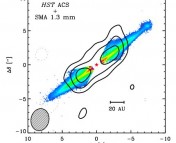Title: On the Origin of Stellar Masses
Author: Mark Krumholz
Institution: UC Santa Cruz
Stars form in environments that are characterized by vastly different densities, pressures and metal content. Yet the sizes of the stars formed don’t vary substantially (as measured by the median mass). Why don’t the properties of the clouds out of which stars fragment more strongly influence the result? Why is there a characteristic stellar mass? Why is this mass scale similar to that required for nuclear burning (the process that fuels stars)? The first step towards understanding this work can be found in models of cloud fragmentation. The resulting distribution of masses can be determined by gas properties such as turbulence, gas pressure and magnetic pressure. However, the absolute mass scale is not determined by these calculations so we need to look to something else.
Stars collapse from the progenitor cloud under the force of their own gravity. The densest regions tend to buckle first and will pull in the surrounding material. As gas falls onto the protostar, its gravitational potential energy decreases and is dissipated as radiation. The emitted photons heat up the surrounding gas, inhibiting further fragmentation and promoting accretion. What mass scale does this process set? Starting from basic equations describing the gravitational collapse of a star, Krumholz shows that the characteristic mass of stars formed is largely independent of the particular properties of the progenitor cloud.
Krumholz’s basic idea is to look at a cloud and figure out what mass accretes onto a star and what mass fragments into a new protostar. This is governed by the pressure and temperature of gas, where the hotter, higher pressure gas found nearer to the star is more likely to accrete. There is also a minimum mass, called the Bonnor-Ebert mass, below which a cloud will not undergo gravitational collapse. Thus, there exists a source of heated gas that will not fragment and instead may accrete onto the star; as the star grows and heats up more of its surroundings, the gas supply is increased. However, the star consumes gas in this reservoir faster than it heats up additional gas. This sets the characteristic stellar mass of the system.
But, Krumholz needs additional constraints to actually find a number. He appeals to the temperature and luminosity of the gas, respectively set by the star’s radiation and accretion rate, and the star’s radius, determined from a mass-radius relation that he derives. These considerations result in a system of five equations that the author solves numerically. He does this multiple times, making different assumptions about stellar structure, the gas profile and material properties of the cloud. The characteristic stellar mass he calculates as a function of interstellar pressure are shown below. As you can see in the figure below, the results are insensitive to the parameters chosen (except at the very-high pressure end; Krumholz notes that most star formation in our galaxy occurs in the left-hand side of the plot anyways).

The characteristic stellar mass as a function of interstellar pressure. The different colors show the results for different parameters; the dependencies are not strong. Fig. 5 from the paper.
These results agree with the observation that the typical stellar mass in a star-forming region is largely invariant. (What small dependencies exist in the plot below are good avenues with which to test Krumholz’s theory.) In addition, it explains why the typical mass is such that nuclear fusion occurs: before fusion commences, the star contracts and heats up, expanding the reservoir of heated gas available for accretion. Once fusion begins, new gas isn’t heated as rapidly and fragmentation becomes more likely than accretion. Thus, the characteristic stellar mass is similar to the mass required for nuclear burning.





Trackbacks/Pingbacks